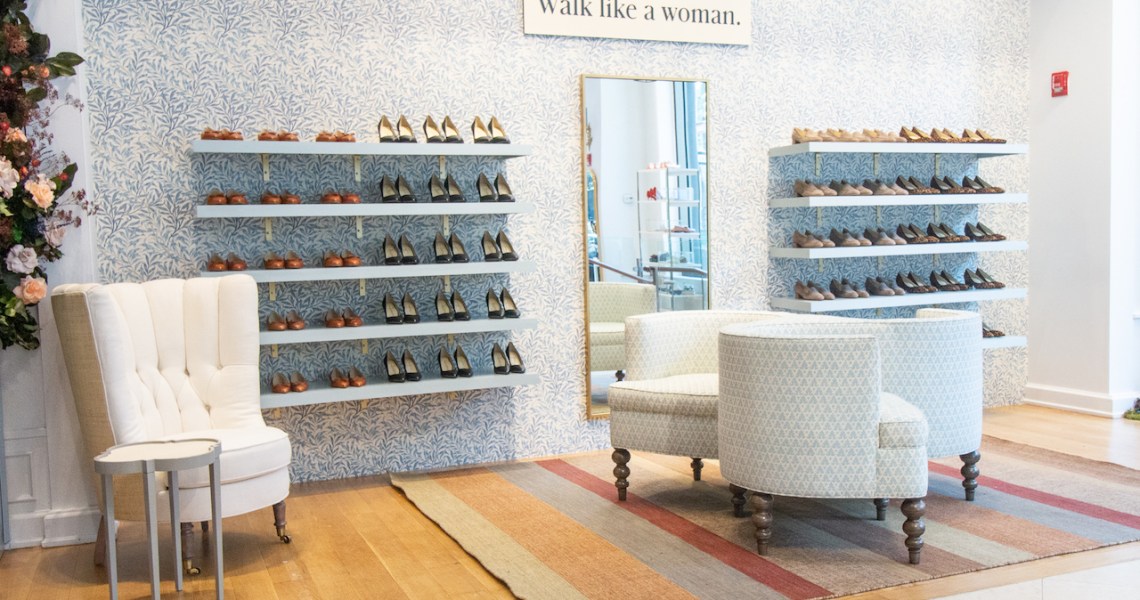To meet shoppers where they are during the holiday season, more digitally native brands are launching physical retail.
Vying for shoppers’ attention at a time when discounts and promotions are running rampant, DTC brands — which are often discount-averse — are centering their fourth-quarter marketing strategies on launching pop-ups and opening stores. Many are entering physical retail for the first time.
Designer Sarah Flint opened the first physical retail space for her namesake brand in early October — a Soho pop-up set to remain open through mid-December. Last year, Flint’s holiday strategy was centered on a buy-more, save-more promotion living exclusively on the brand’s e-commerce site. This year, that same type of promotion will also be offered in-store. For a week starting on Nov. 25, customers can get $100 off two pairs of shoes, for example.
Flint, who declined to share what portion of her company’s sales are made in the fourth quarter, said the pop-up was a direct response to customer demand. “We collect feedback constantly through a number of channels, including making phone calls to customers each week to hear their thoughts,” she said. “The requests for a physical location have been overwhelming.”
Though holiday shopping, like all shopping, is moving online, the shift has been slow. Holiday sales are largely still made in-store, with brick-and-mortar sales accounting for 84% of the total in 2017. Online sales during the season increased by 19% in 2018, according to McKinsey, but still made up just 13%.
For e-commerce brands reliant on Facebook to cut through the clutter, cost-per-click advertising on the platform shoots up 140% from the third week of November to the end of December, according to digital marketing agency Common Thread Collective. And the payoff is far from comparable, at a 1.4% increase in average order value, per data compiled by Shopify.
Physical retail can read like a better deal.
Ad position: web_incontent_pos1
This year, the Unibail-Rodamco-Westfield Group is debuting The Market at Westfield at four of its shopping centers, including NYC’s World Trade Center. The pop-up market is set to be dedicated to first-to-retail and digitally native brands, with the pitch deck promising them an elevated retail experience, adjacent programming to drive foot traffic and customer data, including their dwell time and demographic. Pop-ups are set up with everything from signage to cameras offering facial recognition technology, and brands get marketing support, including social posts, print ads and press releases. According to Westfield, its World Trade Center stores see 10.8 million holiday visitors who spend an average of 40 minutes shopping. A 10 foot-by-10-foot space in the center is $25,000 for the market’s six-week run. The market is set to return next year.
There’s something to be said for the seasonal pop-up, which customers can come to anticipate. Direct-to-consumer outerwear brand The Arrivals, launched its first pop-up in NYC in late 2016 — it was supposed to last three weeks, but sales goals were reached within days, and owner Jeff Johnson opted to keep it open for six months. Since, the company has brought back a pop-up every fourth quarter, each with a unique theme and experiential elements. Each drives “a good portion” of the brand’s annual revenue, according to Johnson. The latest, OutThere Lab, launched in NYC’s Soho neighborhood this month and will stay open through February.
Johnson said finding a space has gotten easier every year, as landlords have come to embrace the idea of temporary tenants. “More spaces are available now,” he said. “This is the new model, industry-wide. For us, the opportunity to attract new eyes [with a pop-up] is unparalleled. Plus, the cost of marketing online is going up. Plus, we’re able to do this in our own backyard [in Soho]. It all makes sense for us.”
In 2018, businesses on Shopify — the go-to e-commerce platform for DTC brands, which reportedly hit 1 million clients last week — processed over $1.5 billion in sales from Black Friday to Cyber Monday. But placing all eggs in one basket is risky, particularly in a crucial sales period.
“Brands need to do everything to be everywhere. You need to mitigate your exposure to a single distribution flaw — meaning that if I’m only e-commerce and Shopify blows up or goes down, that’s a problem for me,” said Matt Scanlan, founder and CEO of Naadam, which does 60% to 65% of its sales from October to December. “The pressure’s especially on during the fourth quarter.”
Ad position: web_incontent_pos2
Scanlan is also CEO of recently relaunched Thakoon, which opened its first store in earlier this month, in time for the holiday rush.
Michael Osborne, CEO of marketing platform SmarterHQ, said digitally native brands don’t need to rewrite their own playbook to win over holiday shoppers, but they can’t sit back as other brands go to battle.
“There’s no need to enter the ‘blanket system’ of over-discounting and over-messaging, and getting tons of exposure,” he said, noting that physical retail isn’t crucial and that, if not done right, it can hurt a brand’s cachet. “They should [instead] use the time to build up their customer base, rewarding the most loyal customers with bigger discounts for referrals or promoting loyalty programs offering perks. And they typically have a distinct point of view, so they should remind customers of what that is — for some customers, that’s enough.”




